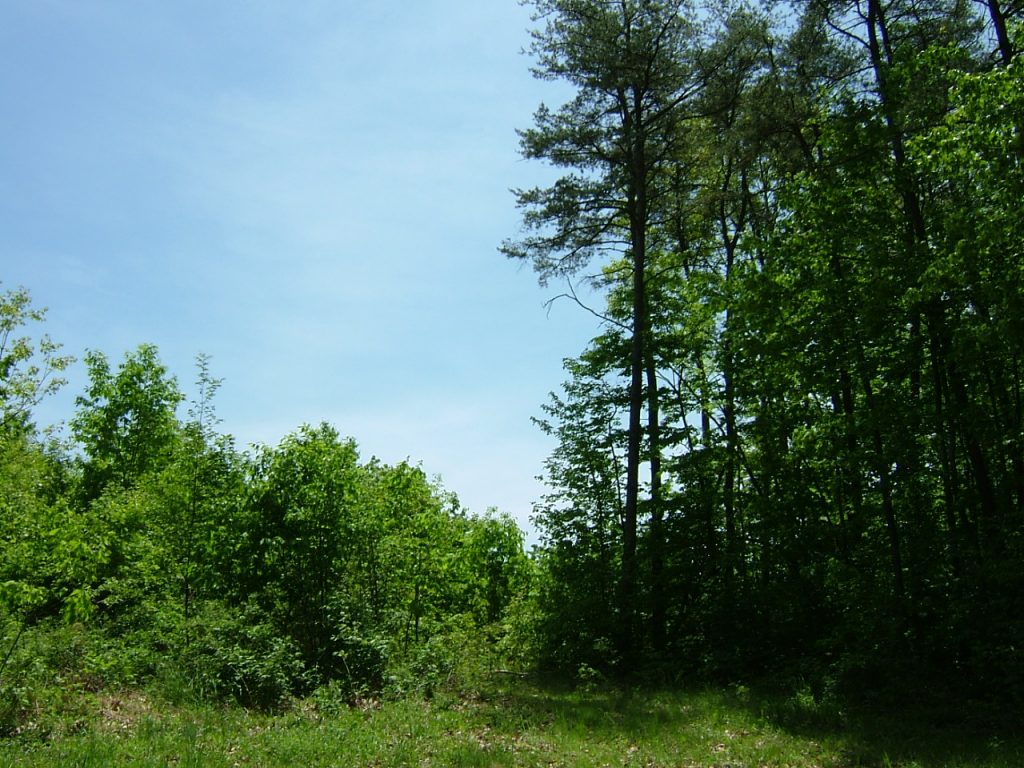Old forests store new nitrogen–and may soak up nutrient excesses
Ecologists working in central Pennsylvania forests have found that forest top soils capture and stabilize the powerful fertilizer nitrogen quickly, within days, but release it slowly, over years to decades. The discrepancy in rates means that nitrogen can build up in soils, David Lewis, Michael Castellano, and Jason Kaye report in the October 2014 issue of ESA’s journal Ecology, published online this week. Forests may be providing an unappreciated service by storing excess nitrogen emitted by modern agriculture, industry, and transport before it can cause problems for our waterways.

A member of the research team plunges into a stand of young trees, heading for a study plot in a central Pennsylvania forest recovering from recent clear-cutting. Credit, David Lewis.
Nitrogen is an essential nutrient, required for all living things to live and grow. Though a major component of the air, it is largely inaccessible, captured only through the metabolism of certain microbes or washed to earth in the form of ammonia, nitrogen oxides, or organic material by rain, snow, and fog. On land, microbes, fungi, and plants incorporate what doesn’t wash away into proteins, DNA, and other biological components. Organic matter in the soil – the remains of fallen leaves, animal droppings, and dead things in various states of decay – can also capture newly deposited nitrogen, holding it stable in the soil.

The tall, mature trees of a late-succession forest (right) stand next to the young regrowth of a clear-cut forest in central Pennsylvania. The deeper volume of organic matter on the floor of a mature forest can capture more of the nutrient nitrogen when it enters the forest than the clear-cut can. Credit, David Lewis.
Mature forests store nitrogen more efficiently than young forests recovering from clear-cuts the authors found, because they have been accumulating organic matter on the forest floor for a century or more. When a forest is clear cut, erosion soon follows, washing away top soil. A young stand of trees a decade old is beginning to rebuild the organic layer, but it will take many autumns to accumulate.
The orderly succession of changes in resident species as a forest grows and ages is a classic preoccupation of ecological theory. The exchange of nutrients among the species and the non-living landscape also changes with succession, and the discovery that nitrogen accumulates in the organic soil indicates something important about how an ecosystem’s nutrient economy ages. It was thought, up through the 1970s and early 80s, that an ecosystem grows like a person. At some point, forests, like people, stop getting bigger and adding new biomass. Ecologists argued that the ability to capture incoming nutrients stopped with the end of growth. But by the mid-80s, it was clear that mature ecosystems did continue to absorb nitrogen, mostly in soil. By showing that nitrogen capture is much faster than its release, Lewis and colleagues suggest a mechanism by which old ecosystems can accumulate new inputs of nutrients.
Because soils rich in organics can quickly incorporate nitrogen, forest soils have the potential to absorb excess nitrogen that has been newly added to the biosphere through human activities. Application of synthetic nitrogen fertilizers and combustion of fossil fuels produce substantial amounts of ammonia and nitrogen oxides. Since industrialization, human activities have tripled the global rate of fixation of nitrogen from the air. The excess has perturbed the nutrient economies of many ecosystems, most visibly by feeding algal blooms and oxygen-deprived dead zones in lakes and estuaries. The study suggests that we may want to strategically conserve or restore forests, preserving organic-rich soils where they intercept the movement of ground water towards streams, lakes, or estuaries.
Forest succession, soil carbon accumulation, and rapid nitrogen storage in poorly-remineralized soil organic matter (2014) DB Lewis, M Castellano, and JP Kaye. Ecology 95(10): 2687-93. [open access]